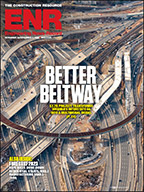Still, Buechner adds that state and local budget issues could have a significant impact on highway and bridge spending for 2010. ARTBA estimates that 19 states are planning to cut highway investment next year. "That�s a black box in terms of what the impact will be," he says.
While a new federal highway bill remains on the horizon, many analysts expect the regular federal highway program to remain at current funding levels. With highway program funding flat and more stimulus yet to come, Murray forecasts a 13% rise to $64.7 billion in total starts.
Several megaprojects�including the $1.6-billion Dulles Corridor Metrorail project in suburban Washington, D.C., and a new $8.7-billion Trans-Hudson rail tunnel connecting New Jersey to Manhattan� have offered a big boost to the mass-transit sector. In 2009, McGraw-Hill Construction estimates that starts jumped 29% to $5 billion, and another 18% rise to $5.9 billion is expected in 2010.
The prospect of billions of dollars for high-speed rail projects could also fuel added work in the coming years, Murray says.
Stimulus funds could help buoy institutional building construction in 2010. After a 23% drop in square footage in 2009, McGraw-Hill Construction forecasts that the sector will flatten out with a drop of 2%. Public buildings got a big boost from the ARRA in 2009 and will reap many of those benefits in 2010. Starts in the sector are expected to rise 8% to 51 million sq ft� on par with the 2007 peak.
Health-care projects took a big hit in 2009 in light of the tight credit market, but they may be on the road to recovery.
McGraw-Hill Construction estimates suggest the sector dropped 36% in 2009 to an estimated 70 million sq ft of new space. That sector is expected to see 72 million sq ft of new starts in 2010.
Simonson says he�s "a bit more optimistic on health-care spending" going into 2010.
"Now that the stock markets have rallied and the bond markets have opened, that will enable health-care systems to resume their multiyear plans," he says. "The demand is still there and now the money is there, too."
Simonson says that, overall, contractors will be particularly vulnerable in 2010 as most nonresidential sectors continue to suffer and existing work comes to completion.
"I think 2010 will be an even more difficult year for most nonresidential contractors than 2009," he adds. "A number of them still had backlogs that they worked through in 2009, but very few have enough to keep them busy through 2010. Only a minority is going to be winning stimulus projects. It will be a tough year."



